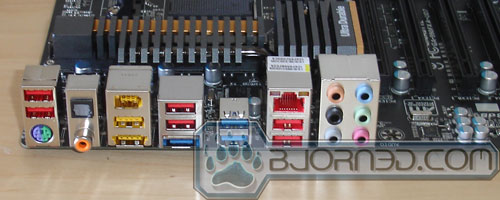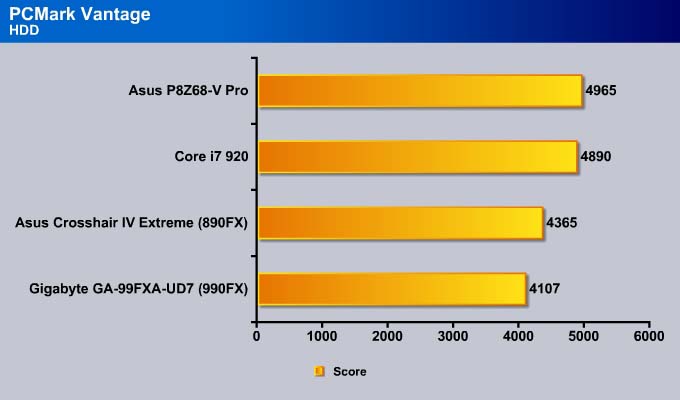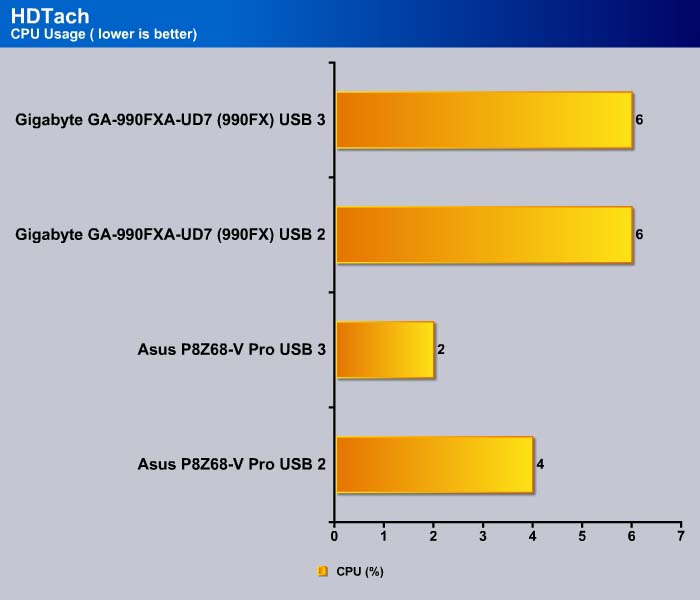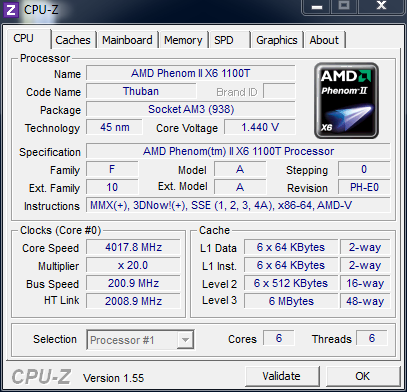The Gigabyte GA-990FXA-UD7 targets enthusiasts with plenty of features. Ready or not, Bulldozer is coming…
Introduction
The launch of the AMD “Scorpius” platform for the performance desktop PC featuring the upcoming Bulldozer processor is finally in motion at Computex 2011 with the releasing of the AMD 9 series chipset. While we have to wait a little longer until we can get our hands on the Bulldozer, the launching of the 9 series chipset from various motherboard manufacturers means that the processor should be coming very soon.
New AM3+ Socket
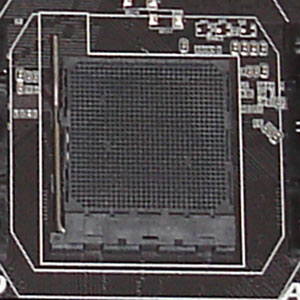
New AM3+ socket (left) and old AM3 socket (right)
AMD has a tradition of offering backward compatibility. So, despite the fact that the board is here before the processor, there is no need to worry that you are going to be spending money and have the board sitting in the cardboard box while waiting for the CPU to arrive. The new 9 series chipset will be Socket AM3+ and will support the upcoming Bulldozer processor, as well as current AM3 processors, so any Ahtlon II or Phenom II will fit into the board without any issue.
Socket-wise, the AM3+ looks almost identical to the AM3. However, if you pay close attention and you will see that the new socket has 942 pins, one more than the AM3. In order to offer backward compatibility, AM3+ continues to place the pins on the CPU as opposed to Intel’s LGA socket where pins are located on the socket. CPUs often get handled more than the motherboard and their smaller size often means they prone to accidents that can result in bent or broken pins. We have never had a processor with damaged pins after swapping the CPU in and out many times, so as long as care is being taken, it should not be an issue. Of course, having the pins on the CPU is much easier when it comes to straightening a bent pin than on the Socket (ever tried to straighten the LGA 1366 with its bendy pins?).
Despite the socket compatibility allowing the AM3+ socket boards to work with AM3 processors, the AM3+ processors are not backward compatible with the AM3 socket. At least that’s AMD’s official statement. However, motherboard manufacturers such as ASUS, MSI, and Gigabyte have all announced that some of the current AM3 boards will be compatible with AM3+ processor. All that is needed is a BIOS update to recognize the new processor. It is yet unknown if there are any performance issues or if the board will support all of the features such as power management and the clock speed throttling in the AM3+ processor. We will have to wait until the processor is here to verify that.
The “New” AMD 990FX and SB950 Chipset
Normally we have the block diagram of a new chipset. However, this time AMD is keeping a pretty tight lid around the platform until it is ready to release any details. While AMD allows motherboard manufacturers to launch the motherboards, they are not yet ready to talk much about the chipset and the processor. All we know at the moment is that the 990FX chipset that was launched is essentially a replacement of the 890FX chipset that launched last year.
The 990FX represents the flagship chipset targeting the enthusiasts and hardcore gamers. The 990FX is essentially the same chipset as the 890FX. The chipset is manufactured by TSMC’s 65nm fabrication process just like the 890FX. The 990FX sports 42 PCI Express 2.0 lanes. 32 of the 42 lanes are split between the two PCIE x16 slots for multi-GPU support in 2×16 or 16+2×8, or 4×8 configurations. It is not a surprise that the board will support AMD CrossFireX in 2 or 3-way configurations. Here is the kicker; the new chipset brings NVIDIA SLI support back to the AMD platform. After a few years of preventing AMD systems from running SLI and forcing motherboard manufacturers to rely on third party chips like the Lucid as seen on the Asus Crosshair IV Extreme, NVIDIA finally granted the SLI license to AMD. The chipset supports 2-way and 3-way SLI. The 990FX’s 10 extra PCI Express 2.0 lanes are split in one PCI-E x4 and six PCI-E x1 which can be used for additional expansion cards or to interconnect other devices such as USB 3.0 and Ethernet.
The Southbridge for the new platform is still the same old SB850 except it is being renamed to SB950. While the chip is a year old, it’s not completely outdated so it is still a good choice. It supports six SATA 6Gbps and 14 USB 2.0 ports. The lack of USB 3.0 is a bit of a disappointment. To be fair, the latest Z68 chipset only supports 2 SATA 6Gbps and does not offer USB 3.0 support. So at least AMD offers more SATA 6Gbps. Still, we would prefer to see USB 3.0 natively supported. There are four additional PCI-E 2.0 x1 lanes available on the chip. Finally, keeping with backward compatibility, the chip still supports the aging PCI 2.2 and parallel ATA.
Features: Gigabyte GA-990FXA-UD7
Our review sample, courtesy of Gigabyte, is the GA-990FXA-UD7. This is the flagship board from Gigabyte that is designed for gamers and enthusiasts.
Features
This slide highlights many of the features on the Gigabyte 990FXA-UD7 board. As you can see the board comes with 8+2 phase power. Gigabyte markets the board with what they call the 333 where the board will support USB 3.0, SATA 3.0 6Gbps, and 3 graphics cards. While the 990FX chipset supports up to three graphic cards, the UD7 can support up to four cards.
The UD7 features 8+2 power phase with Ultra Durable 3 design. It also comes with hardware over-voltage control ICs to provide more voltage control for the CPU, Chipset, and memory. All new 900 series boards from Gigabyte are equipped with the OV control ICs that offer real time voltage control with 10mV minimum stepping. This can potentially lead to higher overclocking by fine-tuning the voltage for each component.
Another new feature is the Driver MOSFET. Traditional VRMs consist of a Choke, Capacitors, MOSFETs, and a Driver IC. The new Driver MOSFET from Gigabyte incorporates the MOSFET and the driver IC into one package. This not only reduces the VRM real estate but according to Gigabyte will also “deliver higher power transfer and increased efficiency at higher switching frequencies to satisfy the growing power requirements of today’s processors.” Ultimately, a more efficient system means lower heat output which would prolong the lifespan of the components and potentially leads to higher overclocking and system stability.
Gigabyte continues to add twice the amount of copper in the PCB to help to reduce the board’s temperature, lower the impedance and the EMI. This in turn helps with better power efficiency, offers better ESD protection, and overclocking of course. In addition, the board uses Japanese solid capacitors and Ferrite chokes to help to expand the lifespan of the board by lowering the power loss.
Turbo XHD
One of the unique feature with the UD7 is the Turbo XHD where it simplifies RAID 0 setup. Conventional RAID setup requires 7 steps involving enabling RAID in the BIOS and going into the RAID configuration menu. Setting up RAID is not particularly difficult for experienced users, but can be rather tedious and may be challenging for a novice to navigate around the BIOS and RAID configuration menu. Gigabyte simplified the job where the board will automatically detect 2 new hard drives and automatically configure the RAID 0 during boot up. So the RAID set up can be as easy as just click “Y” (Yes) after you installed the hard drives during POST.
Keep in mind that this is only 2 hard drives setting up for RAID 0. If you need to configure other types of RAID levels, you would still need to go into BIOS and use the RAID configuration menu.
Cloud OC
Gigabyte introduces Cloud OC where users can overclock their board remotely from any device with a web browser. The device will connect to the board via either Wi-Fi, 3G, or Bluetooth. It provides system status information, real-time OC on the fly, and remote control of the system power state.
To use it, you simply install the Cloud OC on your main system; there is no application to install on your mobile device. Simply enter the IP address on your mobile device’s browser and you will be able to take control of the system.
Specifications
Software Bundle
The board comes with Gigabyte’s 3TB+ Unlocker which allows a 32-bit OS to utilize 3TB or larger drives. Cloud OC is a web based application that allows any network capable device to overclock the system as mentioned above. The Auto Green is designed to conserve power consumption where the system will turn off Bluetooth when the Bluetooth capable device move away from the board.
The board also comes with Gigabyte’s own Windows overclocking and system information tool called EasyTune 6.
Closer look at Gigabyte GA-990FXA-UD7
The Gigabyte GA-990FXA-UD7 is packaged in a very nice looking box where you will find plenty of marketing information on the outside of the box. A handle is provided on the top of the box for you to lug around the giant box to show-off your latest purchase to your friends.
The inside flap has more marketing information detailing some of the features of the board. In addition, a see-through window display the CPU socket and part of the heatsink.
Overall, the UD7 has excellent packaging where the board sits inside a cardboard box and the accessories are located in a separate compartment underneath the board.
Included:
- 2-way SLI bridge
- 3-way SLI bridge
- Crossfire cables
- Two SATA cables
- Manual
- Quick Installation guide
- Back I/O plates
- Driver disk
- two case badges
It is quite a surprise to find the board only comes with two SATA cables. For such a high-end board, we would expect Gigabyte to throw in all the necessary cables.
Our first impression with the UD7 is that it’s one heck of good looking board. We really love the black and gold look of the board. The mixture of dark black and gray with a bit of gold makes the board not overly flashy but at the same time screaming of performance.
It seems like it is almost a standard to have a completely silent motherboard. Even most of the high-end enthusiast motherboards we have reviewed lately feature completely silent heatpipe cooling designs. This movement toward silent cooling is much welcomed. The UD7 continues the movement and features a low profile heatpipe design. The heatsink features a high performance sintered copper heat pipe that interconnects the PWM and the chipset. This helps to conduct the heat generated from the Southbridge toward the back but it also means that if you wish to replace the heatsink with watercooling, you have to replace both simultaneously.
We can see a little copper block with fins extends out of the block and covers the PWM to maximize the surface area for more efficient cooling. And a large area heatsink covers the Southbridge. Both heatsinks are low profile and pose no obstruction for large CPU coolers or graphic cards.
Over at the CPU socket, we can see the new AM3+ socket and the new two bracket design heatsink retention. Unlike the AM3 socket where a single piece of hollow square retention bracket is used, the AM3+ uses two little pieces on either side of the CPU for your cooler. According to the motherboard manufacturers and AMD, this design allows better airflow so the CPU runs cooler. Despite this, an older AM2 or AM3 heatsink would still work without any issue.
Lately we have seen in both Intel and AMD systems that the CPU socket has progressively moved away from the back I/Os and towards the middle bottom portion of the board. This allows a larger CPU heatsink to be used.
Four DIMM slots are available for up to 32GB of DDR3. The board will support DD3 frequencies of 1066/1333/1600/1860/2000 MHz. Surprisingly, the DIMM slots are not color coded. While I am pretty sure enthusiasts know that it’s best to install memory modules in alternating slots for dual-channel modes, it’s still convenient to color code them for people who do not read the manual when comes to installation.
Just next to the DIMM slots is where we find the usual placement of the main ATX power connector. Next it is where you will find the handy Power On/Off button, Reset button, and a clear CMOS button. Enthusiasts always appreciate these onboard buttons when it comes to overclocking. Gigabyte provides a cover over the reset CMOS to prevent it from being pushed accidentally. You will also find a SATA power connector on the edge of the board that will supply additional power to the graphic cards. We like the fact that Gigabyte opted for the SATA connector instead of the 4 pin Molex connector.
Lining the edge of the board are eight SATA 3.0 6Gbps ports. The six black ports are controlled by the AMD SB950 Southbridge that supports RAID 0, 1, 5, 10, and JBOD. The two additional gray SATA 6Gbps ports are controlled by a Marvell 88SE9172. Gigabyte labels them as GSATA ports that support RAID 0 and 1. Additionally, there is another Marvell 88SE9172 chip that provides support for the two eSATA ports on the back I/Os.
A handy LED debug code is provided and right next to it is an excellent placement for the CMOS battery. Two BIOS chips sit behind the SATA ports. Dual BIOS is a very handy tool in the event the primary BIOS is corrupted; the backup BIOS provides recovery. Another neat feature with the UD7 is the Q-Flash where a BIOS flash can be done without the need of entering MS-DOS.
Along the bottom edge of the board is where you will find the usual front panel ports. There are three USB 2.0 internal headers, one USB 3.0 header, one FireWire header, and the front audio header. Gigabyte uses an Etron EJ168 controller for the USB 3.0. Next to the front panel headers is where you find the header for Gigabyte’s Trusted Platform Module (TPM) header that provides hardware based security. In addition, you will find the front panel audio and the SPDIF header.
For cooling, the board comes with three additional fan headers in addition to the CPU fan header. Unfortunately, only one of the three headers can be controlled. We would love to see more control of the fan speed on the board.
The UD7 comes with six PCI-E x16 slots and one PCI slot. Rather than color coding the PCI-E slots indicating which slots to use for optimal performance, Gigabyte uses different tabs. While the slots are physically x16, not all of them are electrically x16. Only the first and the fifth slots are x16 while the rest of them are x8 and x4. We do wish Gigabyte would color code the slots for easier installation.
Personally, we have never liked the pull-away type of tab like what you see being used on slot 1. When working with large graphic cards like the GTX 580, it can be difficult to get your finger to pull the tab in order to release the graphic card. The type of tab that you push inward to release the card like on slot 2 is slightly easier to work with.
We like the fact that the two X16 slots are far apart, with one card space between them for better cooling. The slot placement on the board is also good. However, if you are running two cards, the PCI slot will be blocked. When running three cards, you can either use the slot 1-3-5 which leaves a PCIE x8 or slot 3-5-7 and have the PCIE x16 and PCIE x4 available for expansion. Do not be fooled into thinking that it did not have any PCIE x1 slot for add-on cards, any of the x16 slots will support PCI-E x1 devices.
Also, as seen in the image above, there is enough clearance between the first PCIE x16 slot and the heatsink and the memory slot area.
Around back we get seven USB 2.0 ports, a single USB2.0/eSATA port, two USB 3.0 ports, an eSATA 6Gbps port, a keyboard/mouse PS/2 port, a FireWire port, coaxial and optical audio out, Gigabit Ethernet port, and the standard 6 port audio connector. The Gigabit LAN uses a Realtek RTL8111E chip and the audio is controlled by the Realtek ALC889 codec that offers Dolby Home Theater, 108dB signal to noise ratio, and Blu-ray high quality, full rate lossless audio playback support. The onboard FireWire is controlled by a VIA VT6308 and the USB 3.0 is handled by Eton. This year, we are beginning to see many more USB 3.0 controllers on the market besides those from NEC. The UD7 has a very good mixture of ports and connectors, but we do wish it came with a reset CMOS button on the back I/Os.
The UD7’s USB ports feature what the company called “USB Power 3x” where it delivers three times more power than the conventional USB ports. Thus, its USB 2.0 ports can deliver up to 1500mA as oppose to 500mA and the USB 3.0 ports can deliver 2700mA as oppose to 900mA of power. Traditional USB ports share the power fuses but Gigabyte designs their board where the USB ports have their own fuse. So in the event that a USB fuse is blown, only the port hooked to that particular fuse will not work while the rest of the USB ports will still be fully functional. Having more power through the USB ports offers greater USB devices compatibility and allows you to hook up devices such as external DVD-RWs and HDDs that often need additional power through a second USB port to draw power directly from a single port. And it also allows faster charging of your USB devices even when the computer is in standby or power off mode. The last part, the best in our opinion, is that you can charge your phone even when your computer is completely off.
BIOS
Gigabyte has not yet moved to the UEFI BIOS like Asus. The UD7 uses an Award BIOS and the interface is just what we have come to expect from Gigabyte. One of the biggest advantages with the UEFI BIOS (besides the pretty interface and mouse support) is the support for 3TB, as conventionally BIOS can only boot off a 2TB drive. Fear not, Gigabyte’s BIOS supports what the company calls “Hybrid EIF BIOS” where it will support 3TB drives, despite the fact that it still uses the older interface.
The MB Intelligent Tweaker (M.I.T.) is where Gigabyte places all of the overclocking features of the board.
| CPU | |
| CPU Frequency | 200 ~ 500 MHz |
| PCIE Clock | 100 ~ 150 MHz |
| HT Link Width | Auto, 8bit, 16bit |
| HT Link Frequency | Auto, x1~x10 |
| Memory Clock | x4, x5.33, x6.66, x8.0 |
We like the fact that Gigabyte displays the actual HyperThreading and memory speeds despite the fact the BIOS uses ratio to modify the frequency.
| Memory Adjustments | |
| DCTs Mode | Ganged, unganged |
| CAS | Auto, 4~12 |
| RAS to CAS | Auto, 5~12 |
| ROW Pre Time | Auto, 5~12 |
| RAS ACT Time | Auto, 15~30 |
| DRAM Command Mode | Auto, 1-2 |
| Secondary Timings | |
| RAS to RAS Delay | Auto, 4-7 |
| REF Cycle Time (tRFC) | Auto, 90, 110, 160, 300, 350 ns |
| WRITE Recovery Time (tWR | Auto, 5-8, 10, 12 |
| Precharge time | Auto, 4~7 |
| Row Cycle Time (tRC) | Auto,11~42 |
| Additional Settings | |
| ProcOdt (ohms) | Auto, 240, 120, 60 |
| DQS Drive Strengh | Auto, 0.75x, 1.0x 1.25x 1.5x |
| Data Drive Strength | Auto, 0.75x, 1.0x 1.25x 1.5x |
| MEMCLK Drive Strength | Auto, 0.75x, 1.0x 1.25x 1.5x |
| Addr/Cmd Drive Strength | Auto, 1.0x 1.25x 1.5x, 2.0x |
| CS/ODT Drive Strength | Auto, 1.0x 1.25x 1.5x, 2.0x |
| CKE Drive Strength | Auto, 1.0x 1.25x 1.5x, 2.0x |
| Addr/Cmd Setup Time | Auto, 1/2T, 1T |
| Addr/Cmd Fine Delay | Auto, 0/64~31/64 |
| CS/ODT Setup Time | Auto, 1/2T, 1T |
| CS/ODT Fine Delay | Auto, 0/64~31/64 |
| CKE Setup Time | Auto, 1/2T, 1T |
| CKE Fine Delay | Auto, 0/64~31/64 |
| Channel Interleaving | Enabled, Disabled |
| Bank Interleaving | Enabled, Disabled |
| DQS Training Control | Enabled, Disabled |
| CKE Power Down Mode | Enabled, Disabled |
| Memlock tri-stating | Enabled, Disabled |
Sytem Voltage Adjustements
| Voltage Adjustments | |
| CPU PLL Voltage | 2.025V to 3.135V |
| DRAM Voltage | 1.025V2.135V |
| DDR VTT Voltage | 0.515V ~ 1.145V |
| NB Voltage | 0.865V ~1.975V |
| HT Link Voltage | Auto, 0.728V ~ 1.835V |
| NB/PCIe/PLL Voltage Ctrl | Auto, 1.325V ~ 2.435V |
Interesting to see that the hard drives are shown as IDE rather than SATA under Standard CMOS Features.
Under the Advanced BIOS Features is where you can adjust the CPU features as well as the boot order. Here is where you can enable the EFI boot options which allows you to boot the 3TB drive. With six PCIE x16 slots for multiple cards, Gigabyte lets you to adjust the initial display to any of the six slots.
Integrated Peripherals is where the onboard devices can be adjusted. Gigabyte keeps the default SATA devices as IDE rather than AHCI. A bit odd to find there is a separate RAID 5 setting for the on-chip SATA controller. To use RAID 5, you must enable this option. In order to hot-swap the hard drives, you would have to enable the OnChip SATA Port as ESP. Gigabyte lets you select which port to designate as hot-swappable which is nice.
Under the Onboard PCIE devices is where you can adjust the operating bandwidth of the PCIE slots. Here you can adjust the two primary PCIE slots as either x16 or x8 bandwith.
The Power Management allows adjustment of the ACPI (S1 or S3). In addition, here we can adjust the boot options.
PC Health Status displays the system information and allows adjustment of the system fans. Gigabyte did not offer any manual fan speed adjustments unfortunately.
A very neat feature with the UD7 BIOS is the system information where you get an overview of the hardware components. What is also neat is it displays the BIOS version and the LAN MAC address, a very handy tool.
TESTING & METHODOLOGY
We did a fresh load of Windows 7 64 bit on the test rig, then once we updated the software and drivers to the latest versions, we made a clone copy of the hard drive because we’re going to run this beast like we stole it. We ran each test a total of three times and the average of each test is reported here.
| Test Rig | |
| Case Type | None |
| CPU | Intel Core i5 2500K (Intel)
AMD Phenim II X6 1100T (AMD) |
| Motherboard | Asus P8Z68-V Pro (beta BIOS 8801)
Asus Crosshair IV Extreme Gigabyte GA-990FXA-UD7 |
| Ram | Kingstone HyperX 1600 |
| CPU Cooler | Thermalright SI-128 |
| Hard Drives | Seagate 7200.11 1.5 TB |
| Optical | None |
| GPU | ASUS HD 6870 |
| Case Fans | None |
| Docking Stations | None |
| Testing PSU | Cooler Master UCP 900W |
| Legacy | None |
| Mouse | Microsoft Intellimouse |
| Keyboard | Logitech Keyboard |
| Speakers | None |
aida64 v1.50

“AIDA64 Extreme Edition is a streamlined Windows diagnostic and benchmarking software for home users. AIDA64 Extreme Edition provides a wide range of features to assist in overclocking, hardware error diagnosis, stress testing, and sensor monitoring. It has unique capabilities to assess the performance of the processor, system memory, and disk drives. AIDA64 is compatible with all current 32-bit and 64-bit Microsoft Windows operating systems, including Windows 7 and Windows Server 2008 R2.”
CPU




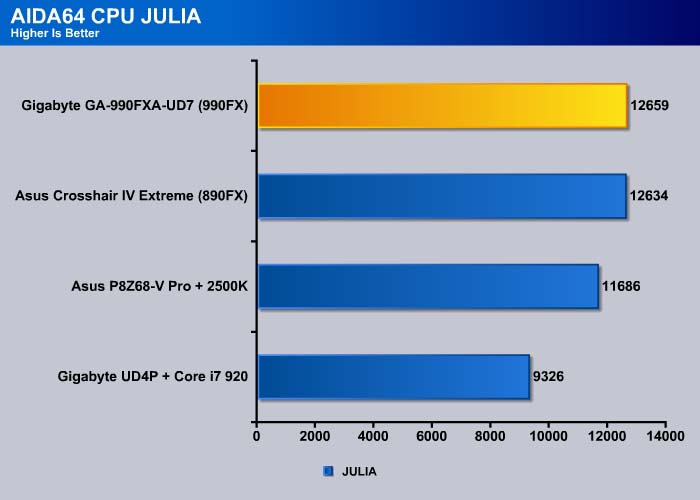




Memory



The Gigabyte board has slightly weaker memory performance than the Asus Crosshair IV. However, the difference is so slim that we doubt it will translate into any noticeable performance difference in real-world use.
Sisoft Sandra 2011b
“SiSoftware Sandra (the System Analyzer, Diagnostic and Reporting Assistant) is an information & diagnostic utility. It should provide most of the information (including undocumented) you need to know about your hardware, software and other devices whether hardware or software. It works along the lines of other Windows utilities, however it tries to go beyond them and show you more of what’s really going on. Giving the user the ability to draw comparisons at both a high and low-level. You can get information about the CPU, chipset, video adapter, ports, printers, sound card, memory, network, Windows internals, AGP, PCI, PCI-X, PCIe (PCI Express), database, USB, USB2, 1394/Firewire, etc.”

The memory tests show that the Gigabyte GA-990FXA-UD7 actually yields slightly higher bandwidth than the ASUS boards. Since the memory controller is built into the processor, we will have to wait until Bulldozer for us to really see a big memory performance gain.
Cinebench R11.5
“CINEBENCH is a real-world test suite that assesses your computer’s performance capabilities. MAXON CINEBENCH is based on MAXON’s award-winning animation software, CINEMA 4D, which is used extensively by studios and production houses worldwide for 3D content creation. MAXON software has been used in blockbuster movies such as Spider-Man, Star Wars, The Chronicles of Narnia and many more. MAXON CINEBENCH runs several tests on your computer to measure the performance of the main processor and the graphics card under real world circumstances. The benchmark application makes use of up to 16 CPUs or CPU cores and is available for Windows (32-bit and 64-Bit) and Macintosh (PPC and Intel-based). The resulting values among different operating systems are 100% comparable and therefore very useful with regard to purchasing decision-making. It can also be used as a marketing tool for hardware vendors or simply to compare hardware among colleagues or friends.”

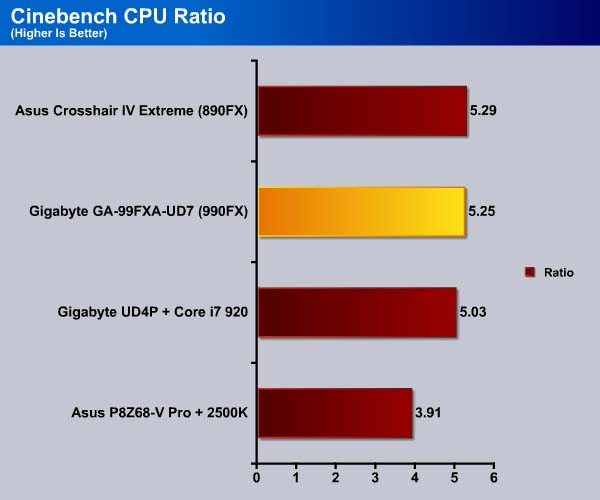
PCMark Vantage
PCMark Vantage is the latest system benchmark tool from Futuremark. The benchmark consists of tests such as application launches, file searches, web browsing, video playback, photo editing, and gaming.
The PCMark overall score has the Gigabyte board scoring 7% higher than the Asus Crosshair IV Extreme.
Virtually identical here between the two boards.
The TV and Movies test consists of transcoding video. The slightly higher memory bandwidth from our Gigabyte board helped out slightly with the performance.
The PCMark Vantage gaming benchmark shows the best case scenario, so take the score with a grain of salt. The higher memeory bandwidth and the core efficiency probably played a role helping the Gigabyte board achieve a 1% gain over the 890FX.
The music test consists of transcoding MP3 to WMA and adding music to Windows Media Player. While music transcoding is not particularly CPU bound, it does reflect real-life situations. Here the situation is reversed where the Asus board edges out the Gigabyte board.
The Communications suite involves light multitasking of data encryption and web page rendering. The Gigabyte board is 5% faster here.
The Productivity test involves four simultaneous tasks that consist of searching contacts in Windows Contacts, searching emails, web page rendering, and application loading. This test simulates common desktop usage with multiple tasks going on at the same time.
Here, the Gigabyte board is about 2.6% faster than the Asus board.
The HDD suite specifically tests the hard drive performance and we can see here that despite the same SB chipset, the Asus board scored slightly higher points here.
3DMark Vantage
For complete information on 3DMark Vantage Please follow this Link:
www.futuremark.com/benchmarks/3dmarkvantage/features/
The newest video benchmark from the gang at Futuremark. This utility is still a synthetic benchmark, but one that more closely reflects real world gaming performance. While it is not a perfect replacement for actual game benchmarks, it has its uses. We tested our cards at the ‘Performance’ setting.


Crysis warhead
Crysis Warhead is the much anticipated standalone expansion to Crysis, featuring an updated CryENGINE™ 2 with better optimization. It was one of the most anticipated titles of 2008.
We ran Warhead using gamer’s setting at a resolution of 1280×1024 and DirectX 10. We tested both no AA and 2x AA.
Dirt 2
Dirt 2 is the squeal to the popular racing game Colin McRae Dirt. This is a standard racing game, but with an off road twist. Instead of racing Bugattis and Porsches, players race trophy trucks and rally cars.
Again, we put the Core i7 920 OC to 2.8GHz against the X6 1075T and tested them with Dirt 2. In this game, we use high setting at 1280×1024 with no AA and 2xAA.
The performance difference is narrowed at a higher game detail setting.
No matter how you look at it, there is virtually no major noticeable difference in the gaming performance between the 980FX and the 880FX. This leads us to ask the question, should you upgrade the motherboard if you have already got the 890FX? We think the answer is wait and see. We suggest you wait until Bulldozer comes to the market and we have looked at its performance before you make the decision. For people who currently have an AM3 board that is based on the 890FX chipset, the only real reason that you may even consider upgrading to the 990FX board is if you need to run SLI. With native support for SLI with the 990FX, you can finally enjoy SLI performance without an additional chip like the Lucid Hydra.
However, if you are in the market for a new AMD built and are wondering if you should get an 890FX (which should be cheaper) or the newer 990FX board that offers natively supports for AM3, our answer is to go with the newer board. While there is not much performance difference between the two chipsets, having an AM3+ board with official support for Bulldozer should offer you a much longer upgrade path. AMD has traditionally offered a good upgrade path for their platforms. If you choose AM3 boards, it is possible that they may allow you upgrade to the first AM3+ processors but it may not support future AM3+ processors. However, having a native AM3+ board will at least offer some insurance that it would be compatible with future AM3+ processors. Furthermore, some features on the upcoming AM3+ processor could potentially only be available on AM3+ socket boards and not on the AM3 boards.
STORAGE
SATA
The Intel Z68 Express chipset has a better burst rate than the P67, and slightly faster read, but it is slower in the write speeds for SATA II. With SATA III, we see the burst rate is a tad slower for the Z68 but the read and write are similar to the P67. The Marvell controller on the P8Z68-V Pro has improved its write performance but it is still not able to catch the Intel controller.
The random access time is about the same for all motherboards.
For CPU usage, the Z68 tends to consume slightly more CPU cycles than the P67 in both SATA II and SATA III.
USB
The USB 2.0 performance is about the same for P67 and the Z68. The USB 3.0 on the P8Z68-V Pro is controlled by ASMedia while the P67 boards use the NEC controller. We can see that the ASMedia controller offers a slightly better average read, but it falls behind in the average write.
There are no major differences between the latency.
The CPU usage is also almost identical.
POWER CONSUMPTION
We ran Prime95 to stress the CPU in order to measure the overall system power consumption. All of the power saving features (C&Q and SpeedStep) have been enabled, as we envision this is how most people will be running their system.
The Gigabyte UD7 consumes about 10 watts less power than the Asus Crosshair IV Extreme. Since both the 990FX and the 890FX are using 40nm fabrication process, we do not expect the power consumption to be much different. Thus, the difference in power consumption is most likely due to the motherboard design.
OVERCLOCKING
Overclocking the Phenom II X6 1100T Black Edition is simple because the system’s clockspeed can be raised by increasing the multiplier or the base clockspeed. We expect that AMD will continue selling Black Edition chips when Bulldozer comes, so overclocking on Bulldozer should be more or less the same, especially if you are purchasing one of the Black Edition models.
We were able to overclock our Phenom II X6 1100T to 4GHz just like what we were able to do with the Asus Crosshair IV Extreme. To get to such a speed, we had to raise the NB voltage to 1.2V, HT Link Voltage to 1.3V, and CPU Voltage to 1.4V. The CPU voltage is higher than what we had to do with the Crosshair IV board.
Our overclocking result is limited by the processor because 4GHz is the sweet spot for 45nm six core processors. We had better success with the quad core processor where we can break the 4GHz barrier. It would be interesting to see if the board is able to push the 32nm Bulldozer once it’s out.
Conclusion
As expected the latest AMD 990FX/SB950 shows no significant performance gain over the last generation chipset from AMD (890FX/SB850). The new chipset is essentially identical except it offers native support for Bulldozer and NVIDIA SLI. While we are disappointed that there is not a major update to the new chipset, especially with the lack of native USB 3.0, we are at least glad to see that AMD still continues with its backward compatibility support.
At the moment there is really no need to upgrade to a 990FX chipset based board if you have an 890FX chipset board unless you are looking to run SLI on your board. However, if you have an older AMD AM2+/AM3 board that lacks SATA 3.0 support and wish to upgrade to a newer board, the 990FX is definitely worth checking out especially, with Bulldozer around the corner.
The Gigabyte GA-990FXA-UD7 is one of the top of the line AM3+ boards available on the market today. The board features plenty of neat features such as six PCIE slots for 4-way multi-GPU support, PC-off USB charging, and Turbo HXD. The onboard debug code, reset CMOS button, power button, and the low-profile heatsink are all welcome features to have for an enthusiast. While we would like the board to feature UEFI like Asus does, we are at least glad to see the board will support 3TB drives despite lacking UEFI. We do, however, wish the board had better fan speed control.
All in all, the UD7 is definitely worth considering if you have your eye on a Bulldozer-ready board. Let’s just hope when Bulldozers arrive, we can take advantage of its performance and the SLI.
| OUR VERDICT: Gigabyte GA-990FXA-UD7 | ||||||||||||||||||
|
||||||||||||||||||
| Summary: The Gigabyte GA-990FXA-UD7 is one of the top of the line AM3+ motherboards available on the market today, and for that we give it our Bjorn3D Silver Award. |
 Bjorn3D.com Bjorn3d.com – Satisfying Your Daily Tech Cravings Since 1996
Bjorn3D.com Bjorn3d.com – Satisfying Your Daily Tech Cravings Since 1996



























